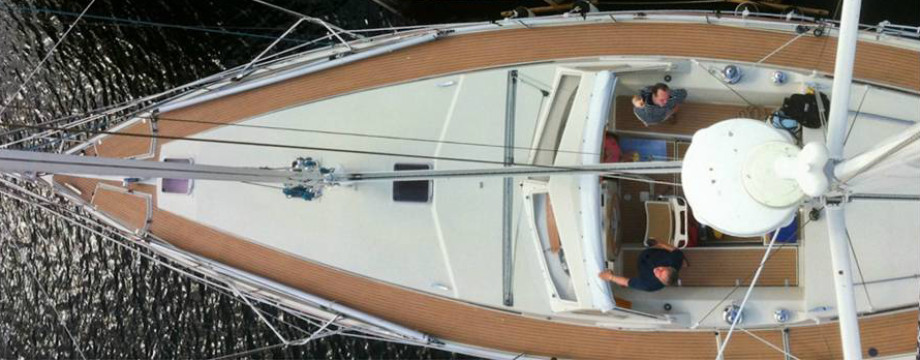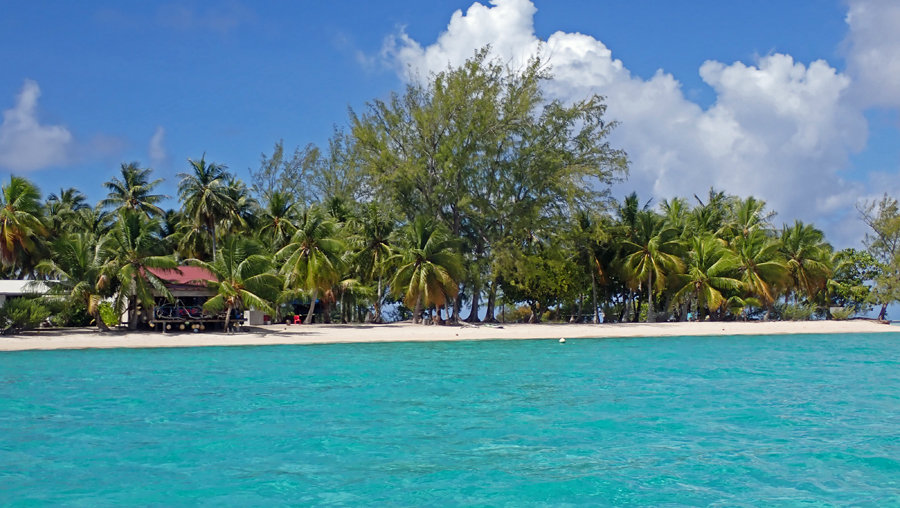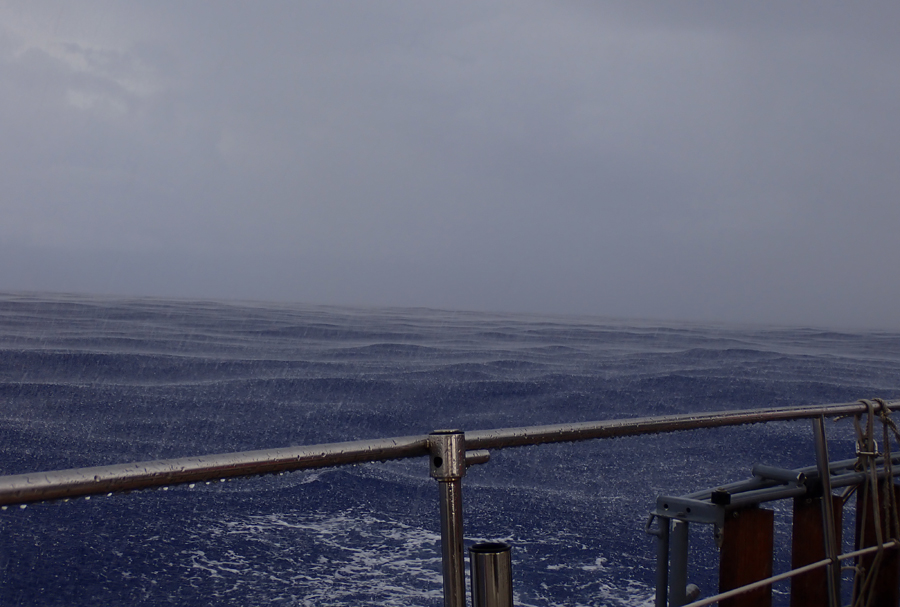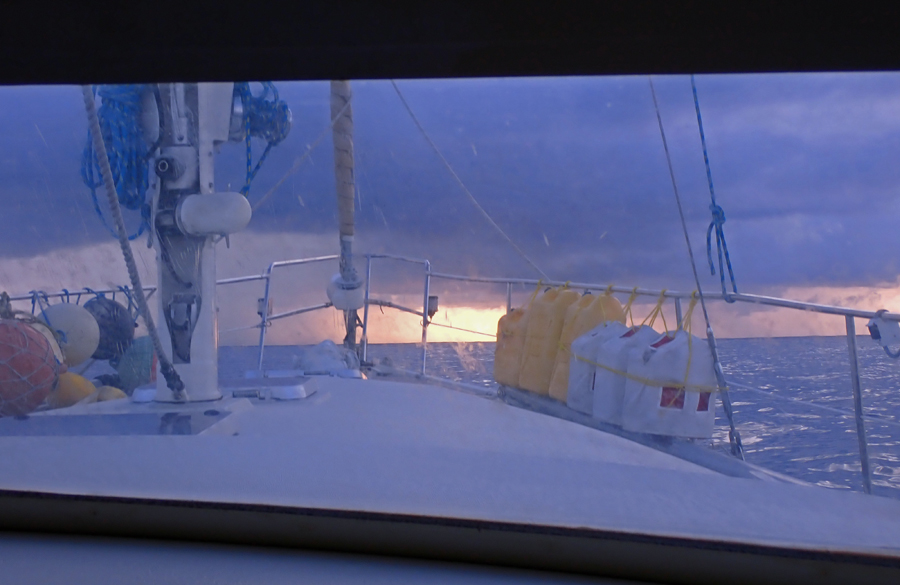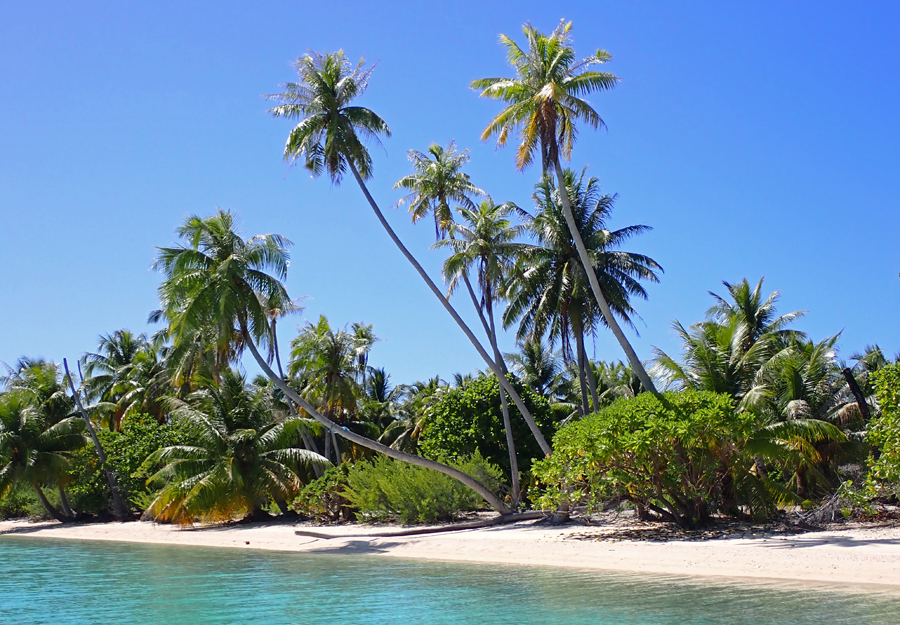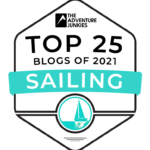We are anchored in Fakarava. Where the heck is that, you might ask. Don’t worry if you’ve never heard of it. Unless you are a sailor passing through the South Pacific or a world-traveling SCUBA diver, the chances are you have no idea where we are. It’s not like Fakarava is high on any geography class syllabus.
Fakarava is a part of the Tuamotu group of atolls in French Polynesia. It is the second largest atoll in French Poly and is about 60 km long (37 miles) and 21 km wide (13 miles). There are two openings into Fakarava. On the northern end is Passe Garuae. This is a wide channel and easy to navigate. On the southern end is Tumakohua. The southern pass is renowned for drift diving and marine life (more on this in some later post once we have a chance to explore).
The population of Fakarava is just under 900 people. They make a living pearl farming, in tourism-related businesses, and sea cucumber fishing in the eastern part of the lagoon which are for export to Asia. The main village is called Rotoava and is located on the northeastern side. But if you look at Google Earth, you will see small houses all over the atoll and even homes located on the very small islands making up the atoll. A small island is called a Motu.
There is an airport for smallish planes and a sea port. Everything here is imported. And, I mean everything. The only exception is perhaps fresh fish caught by local fishermen. Needless to say, we are fully stocked.
I am going to go on a bit of a tangent now about eggs. Bear with me. We have 12 dozen eggs aboard. And, we both feel very guilty about this. There is an egg shortage in French Polynesia and we both feel bad about having more than our fair share. The shortage has something to do with not being able to get young chicks to the islands for layers. Just about all stores have a limited number of eggs and often run out during the day.
As a part of our provisioning, whenever one of us passed any store known to normally sell eggs, we’d stop in an by a dozen. We started to stockpile ahead of our departure date. In a couple of the stores where we’ve become recognizable regular customers, they would go to the back to get us the eggs. We’ve learned both the French and Tahitian pronunciation of eggs and how to ask for them. I guess on the bright side, we are no longer there to buy more eggs so now other people have a chance.
As we hatched (pun intended) our exit plan from Tahiti, we knew our first stop would be somewhere in the Tuamotu group of atolls. The question is where we begin. Most cruising sailors visit these islands in an east to west order beginning with the Marquesas Islands, typically Nuku Hiva. This is the normal entry point to French Polynesia. They then work their way westward with the trade winds at their backs. This was our plan but the shit hit the fan.
If you recall, on our way to French Polynesia, we were just a few hours out of Nuku Hiva when we received a message from DPAM and the JRCC (French Polynesian ocean governing agencies) to re-route to Tahiti due to the Covid outbreak. This is where we’ve been parked ever since. Now, because of these trade winds, we are going to be like a salmon swimming upstream as we venture in any eastward direction to catch up on what we missed the first time through.
I think we’ve given up on ever going to the Marquesas Islands, our planned initial first port of call. The uphill slog is not something we want to do. To be honest, I don’t think we are missing that much based on conversations with people who were there or have been there. The Marquesas don’t really offer much more than what we can find on other islands downwind from us. It’s a little bit of a shame because we were so close at one point. But we are okay with not visiting.
One of the obstacles about heading back east this time of year is the wave size. Systems push through the roaring forties pushing massive waves northward making the Tahitian surfers very happy. If this is combined with strong easterly trades (normal for this time of year), the ocean will be nasty. The waves opposing the wind cause a washing machine effect churning waters and making life aboard absolutely miserable while underway. We needed either the waves or the wind to be a non-factor to make this passage as comfortable as possible. We do see periods of some calm winds but they last for maybe one or two days. Given a choice, it’d be nice to have both a favorable wind and no opposing waves. Alas, this is wishful thinking.
Our plan was, in a single weather window we wanted to push as far east as possible. This way when we arrive, we have the trades at our back for visits to other atolls that now lay westward of us. We looked at going to Rangiroa. This would be easier for us since we could do it with one overnight sail, a shorter weather window, and a more northward passage. However, once there, we’d constantly be looking for a way to get east again because we definitely have Fakarava high on our list. We wondered if we can get to Fakarava in one try.
About 60 days ago, we started to watch weather patterns very closely. We see some small windows of a day or two of calm winds, then all hell breaks loose. We prefer not to sail when all hell breaks loose. Patience is the real key here. There are a couple of chances to get to Rangiroa but we let them pass and keep hoping.
Getting to Fakarava is a little bit trickier than Rangiroa. Besides it being more eastward, it requires us to be out for two nights – 3 days. Every time we move Cream Puff, things start with us looking at the weather and the route. The route part is pretty easy, it just about 250 miles NE of Tahiti. We can easily sail 170 miles per day so we’re looking at one overnight, right? Nope. Not so fast. We have to arrive at the atoll within a certain time frame or risk having to lay up outside and wait to enter. This is due to the very strong currents flowing at the exit/entrances during tidal changes. We need to enter Fakarava atoll during a slack tide. This means either a peak high tide or low tide. The current is slack as the tide changes from one phase to another.
Weather windows are a bit of a gamble. A weather forecast is normally accurate for 3 days. Beyond this, it’s an educated guess. We use multiple sources for weather and when they all agree, we can feel somewhat confident in the forecast. If they disagree, we stay put.
The sad thing about weather windows is the perfect scenario might appear in the 10-16 days forecast. Then, things still look favorable in the 7-10 day forecast. At this point, we might make plans to leave. This includes loading the boat with food. Then, the 3-7 day forecast still shows the window we’ve been looking for. At this point, we might file a float plan with our third land-based crew member and load up on fresh veggies and fruit. Then alas, all of a sudden the window might disappear. This is the reality of our lifestyle when moving.
The above scenario is exactly what happened to us. We were 2 days from departure and the countdown began. Cindy looked at the weather and relayed the bad news. The calm winds had pushed further north and we needed to abort. We had even filed are departure Society Islands paperwork with the French authorities and told the marina we’d be leaving. On the bright side, we had lots of fresh food.
A few days later, another window starts to appear. We don’t get our hopes up. But, we watch with eager anticipation. This window is slightly different and means three days of motoring. We’re not thrilled about the prospect of listening to our diesel engine for three days but we really want to go. The window was very slim. This is how it panned out perfectly for us.
We depart Tahiti on Saturday when conditions at Tahiti call for rain and unsettled weather. For the past week in Tahiti the winds have been howling. Saturday and Saturday night we push northeast. We have some light wind on the nose but we remain on the side of Tahiti where we are protected from big waves. On Sunday and Sunday night, we are in the big waves but the winds die to just about nothing. The waves are far apart and not too uncomfortable. Early Monday morning we can arrive at Fakarava for a 6 am slack tide. Now comes the tricky part. We have to get across the 60 km long (37 miles) atoll and find a good spot to anchor because on Tuesday we know all hell breaks loose.
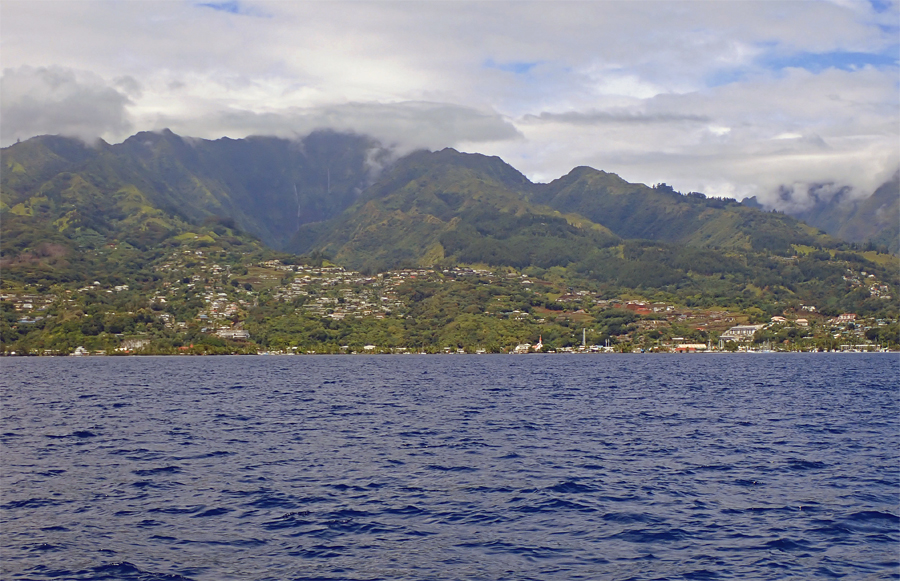
Leaving Tahiti – This island is as stunningly beautiful as we remembered when we arrived 2 years ago. We watch the coastline off our starboard side. If you look closely in the mountains you can see waterfalls.

Lost of rain during our trip. Amels are good boats to have in these conditions. We have no issue staying dry and don’t need to wear raingear.
I am pleased to say, the forecast was dead on and everything went exactly as planned. We dropped the anchor ahead of the incoming weather. Over the next few hours, other boats arrived in the same area all seeking a haven for the next five days.
I was loathing the journey. I really wanted to sail. We have brand new sails yet to be used. These will have to wait until a later time. I hate having to use the motor but it got us to where we wanted to be. I often have to remind myself it is not the journey but more the destinations I enjoy. This is a surprise to me.
I used to love sailing. Any day in our land lives where we could take the boat out put a bounce in my step. I truly expected my love of sailing to carry forward into our lifestyle. But, it didn’t. I’m not sure where things changed but it was early on after we departed St. Petersburg Florida to set sail full time. Don’t get me wrong. It’s not that I despise sailing. I don’t. I just don’t love it like I used to.
Sailing also hurts more than it used to. You might think I’m a little weird after reading the last sentence. We’ve been out here for 7+ years now and age is starting to creep up. While underway the boat is constantly moving and we use muscles most people have no idea they have to keep ourselves upright. Even sitting, we find out butt muscles hurt as we counteract the rolling of the boat. This past passage was a little harder still since we have not used these muscles in quite some time. Even my toes hurt.
It is now the destination that excites me more. The bounce in my step comes from the thought of entering a new port and seeing something totally new to us.
When we departed Tahiti, we were approaching almost 2 years in the same spot. Our plan going into the marina was made during the height of the first Covid epidemic. We decided to park for a little while whilst the world came back to some sense of normalcy. We honestly didn’t expect it to be 2 years. But in all honesty, it’s been a great two years.
We watched as some of our friends departed for New Zealand or Fiji as they opened to boaters but with all sorts of regulations and caveats attached. Others left the more populated French Polynesian islands for the sparsely inhabited atolls. Our plan was to just sit things out and wait. We were near excellent healthcare facilities and had access to Covid vaccinations. Why move? As I look back on our decision to park, I feel blessed we were in a country with long-stay visas, limited lock-downs and restrictions, fabulous inexpensive healthcare, and a government that quickly seemed to grasp the ever-changing environment of the epidemic.
I am going to miss stepping off the boat and being in the middle of downtown Pape’ete. Within just a few steps of the boat was a great farmers market, bakery, restaurants, shops, ice-cream parlor, and the close proximity to just about everything we could want or need. However, I am now going to enjoy jumping off the back of the boat into crystal clear water, absolute quietness, and exploring a place where very few people venture.
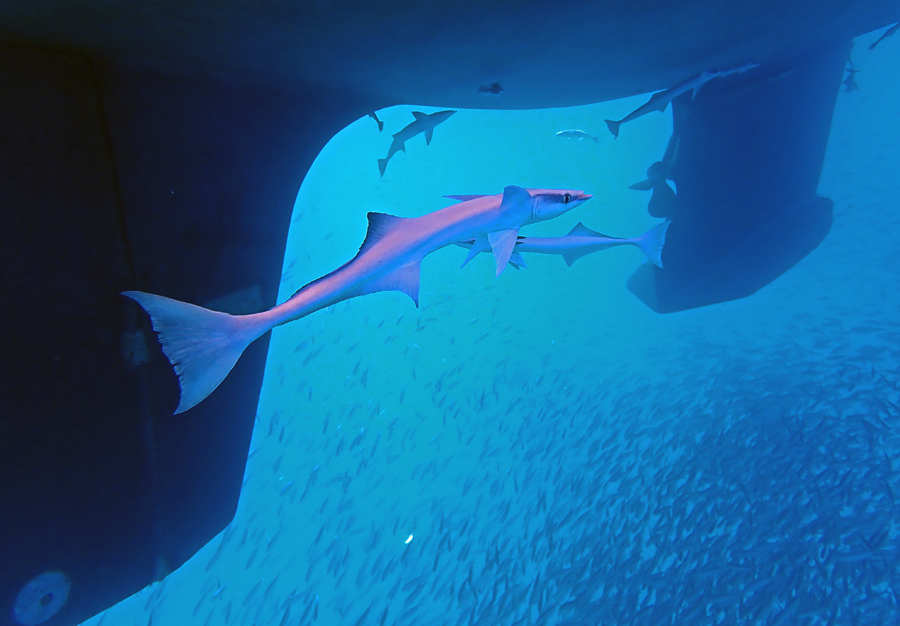
It didn’t take long before the Fakaravan fish discovered a new shady spot under our keel. The larger fish are Remoras (they like to stick to things)
